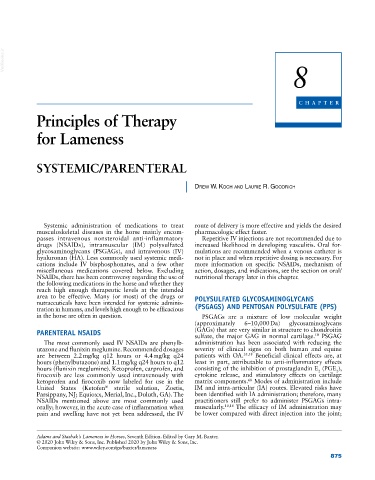Page 909 - Adams and Stashak's Lameness in Horses, 7th Edition
P. 909
VetBooks.ir
8
CHAPTER
Principles of Therapy
for Lameness
SYSTEMIC/PARENTERAL
Drew w. Koch anD Laurie r. GooDrich
Systemic administration of medications to treat route of delivery is more effective and yields the desired
musculoskeletal diseases in the horse mainly encom- pharmacologic effect faster.
passes intravenous nonsteroidal anti‐inflammatory Repetitive IV injections are not recommended due to
drugs (NSAIDs), intramuscular (IM) polysulfated increased likelihood in developing vasculitis. Oral for-
glycosaminoglycans (PSGAGs), and intravenous (IV) mulations are recommended when a venous catheter is
hyaluronan (HA). Less commonly used systemic medi- not in place and when repetitive dosing is necessary. For
cations include IV bisphosphonates, and a few other more information on specific NSAIDs, mechanism of
miscellaneous medications covered below. Excluding action, dosages, and indications, see the section on oral/
NSAIDs, there has been controversy regarding the use of nutritional therapy later in this chapter.
the following medications in the horse and whether they
reach high enough therapeutic levels at the intended
area to be effective. Many (or most) of the drugs or POLYSULFATED GLYCOSAMINOGLYCANS
nutraceuticals have been intended for systemic adminis-
tration in humans, and levels high enough to be efficacious (PSGAGS) AND PENTOSAN POLYSULFATE (PPS)
in the horse are often in question. PSGAGs are a mixture of low molecular weight
(approximately 6–10,000 Da) glycosaminoglycans
PARENTERAL NSAIDS (GAGs) that are very similar in structure to chondroitin
sulfate, the major GAG in normal cartilage. PSGAG
10
The most commonly used IV NSAIDs are phenylb- administration has been associated with reducing the
utazone and flunixin meglumine. Recommended dosages severity of clinical signs on both human and equine
are between 2.2 mg/kg q12 hours or 4.4 mg/kg q24 patients with OA. 35,58 Beneficial clinical effects are, at
hours (phenylbutazone) and 1.1 mg/kg q24 hours to q12 least in part, attributable to anti‐inflammatory effects
hours (flunixin meglumine). Ketoprofen, carprofen, and consisting of the inhibition of prostaglandin E (PGE ),
2
2
firocoxib are less commonly used intravenously with cytokine release, and stimulatory effects on cartilage
ketoprofen and firocoxib now labeled for use in the matrix components. Modes of administration include
68
United States (Ketofen sterile solution, Zoetis, IM and intra‐articular (IA) routes. Elevated risks have
®
Parsippany, NJ; Equioxx, Merial, Inc., Duluth, GA). The been identified with IA administration; therefore, many
NSAIDs mentioned above are most commonly used practitioners still prefer to administer PSGAGs intra-
orally; however, in the acute case of inflammation when muscularly. 10,18 The efficacy of IM administration may
pain and swelling have not yet been addressed, the IV be lower compared with direct injection into the joint;
Adams and Stashak’s Lameness in Horses, Seventh Edition. Edited by Gary M. Baxter.
© 2020 John Wiley & Sons, Inc. Published 2020 by John Wiley & Sons, Inc.
Companion website: www.wiley.com/go/baxter/lameness
875

